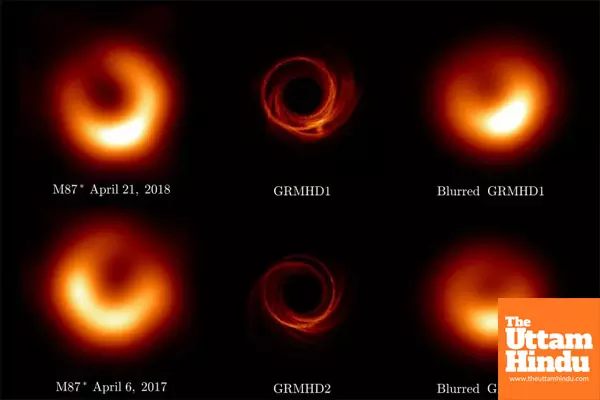
M87’s Black Hole in Motion: Stunning New Findings From the Event Horizon Telescope

Washington DC (The Uttam Hindu): Researchers working with the Event Horizon Telescope (EHT) have made significant advancements in our understanding of the supermassive black hole at the center of the galaxy M87, unveiling new insights into its rotation and the turbulent gas surrounding it. By comparing data from 2017 and 2018, scientists have confirmed earlier predictions and deepened their understanding of the dynamic environment around black holes, paving the way for future discoveries as they continue to analyze more recent data.
Black Hole Dynamics: The EHT Collaboration has utilized multi-year observations to provide fresh insights into M87* — the supermassive black hole at the heart of Messier 87. By incorporating an expanded library of over 120,000 new simulated images, the team has taken black hole research further, revealing that M87*’s rotational axis is directed away from Earth. They also highlight the importance of turbulence in the black hole’s accretion disk, the swirling gas around it. This turbulence helps explain the shift in the brightest section of the black hole’s ring between 2017 and 2018. These findings, published in *Astronomy & Astrophysics*, mark a major step forward in our knowledge of black hole behavior and dynamics.
Advances in Theoretical Understanding : This research provides new theoretical perspectives on the extreme processes that govern black holes and their environments. Hung-Yi Pu, an assistant professor at National Taiwan Normal University, noted, “The black hole accretion environment is turbulent and dynamic. By treating the 2017 and 2018 observations as independent measurements, we gain a fresh perspective on the black hole’s surroundings.” The team’s work underscores the value of observing the evolving black hole environment over time.
Validation of Predictions and Future Outlook : The 2018 data confirm the presence of the luminous ring first seen in 2017, with a diameter of about 43 microarcseconds — matching theoretical predictions for a 6.5-billion-solar-mass black hole. Remarkably, the brightest part of the ring shifted by 30 degrees counter-clockwise. Abhishek Joshi, a PhD candidate at the University of Illinois Urbana-Champaign, explained, “In our original interpretation of the 2017 data, we predicted the brightest region would shift counterclockwise. It’s exciting to see the 2018 observations confirm this prediction.”
Deepening Understanding with Enhanced Data : The 2018 data also reinforce the previous interpretation of the black hole’s orientation, with the brightest region located on the bottom, suggesting the black hole’s rotational axis points away from Earth. By using a newly developed library of simulated images three times larger than that used in 2017, the team has refined its analysis of accretion models. León Sosapanta Salas, a PhD candidate at the University of Amsterdam, explained, “Gas spiraling into the black hole can flow either in the same direction as the black hole’s rotation or in the opposite direction. Our findings suggest that the latter is more consistent with the multi-year data, which exhibit greater turbulent variability.” With further data analysis from 2021 and 2022 already underway, researchers anticipate even deeper insights into the turbulent flow surrounding M87’s black hole.
Event Horizon Telescope Collaboration : The EHT is an international collaboration of over 400 researchers spanning Africa, Asia, Europe, and the Americas, working to capture the most detailed images of black holes by creating a virtual telescope the size of Earth. This effort links powerful telescopes worldwide, including ALMA, APEX, the IRAM 30-meter Telescope, and others, achieving the highest angular resolution in astronomy to date. The data is processed at institutions like the Max Planck Institute for Radio Astronomy and the MIT Haystack Observatory, with further analysis performed by the global team. With contributions from 13 leading research institutions, the EHT continues to break new ground in our understanding of black holes, combining cutting-edge technology and global collaboration to explore some of the universe's most enigmatic phenomena.

